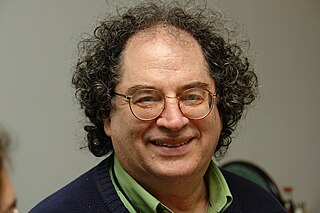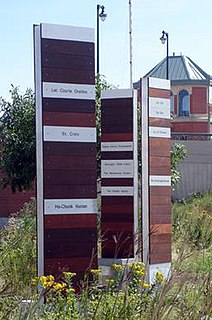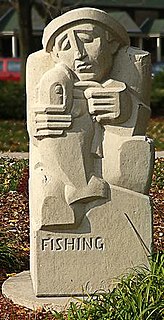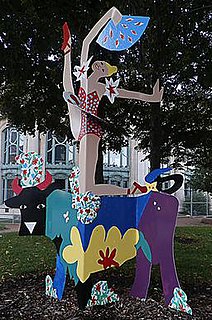
The Milwaukee Art Museum (MAM) is an art museum in Milwaukee, Wisconsin. Its collection contains nearly 25,000 works of art.

The Massachusetts Museum of Contemporary Art is a museum in a converted Arnold Print Works factory building complex located in North Adams, Massachusetts. It is one of the largest centers for contemporary visual art and performing arts in the United States.

RiverSculpture! are public art displays found along the Milwaukee Riverwalk in downtown Milwaukee, Wisconsin. Information kiosks stationed near each presentation offer self-guided walking tours of this annual outdoor exhibition.

The Historic Third Ward is a historic warehouse district located in downtown Milwaukee, Wisconsin. This Milwaukee neighborhood is listed on the National Register of Historic Places. Today, the Third Ward is home to over 450 businesses and maintains a strong position within the retail and professional service community in Milwaukee as a showcase of a mixed-use district. The neighborhood's renaissance is anchored by many specialty shops, restaurants, art galleries and theatre groups, creative businesses and condos. It is home to the Milwaukee Institute of Art and Design (MIAD), and the Broadway Theatre Center. The Ward is adjacent to the Henry Maier Festival Park, home to Summerfest. The neighborhood is bounded by the Milwaukee River to the west and south, E. Clybourn Street to the north, and Lake Michigan to the east.

The Milwaukee Institute of Art & Design (MIAD) is a private college of art and design in Milwaukee, Wisconsin. Founded in 1974, it offers a Bachelor of Fine Arts degree in 5 majors: Communication (Graphic) Design, Illustration, Industrial (product) Design, Interior Architecture and Design, and New Studio Practice: Fine Arts. The college also offers 18 academic minors in areas such as Furniture Design, Digital Media Production and Arts Management. MIAD is considered the successor to the Layton School of Art, and was formerly known as the Milwaukee School for the Arts.
Paul Druecke is an American artist who works at the intersections of poetry, sculpture, video, and photography. His work was included in the 2014 Whitney Biennial at the Whitney Museum of American Art and anthologized in Wiley Blackwell’s Companion to Public Art. His project, A Social Event Archive foreshadowed the role of social media in blurring boundaries between personal and public. The Archive was the focus of a solo exhibition at the Milwaukee Art Museum (2017) on the 20th anniversary of its inception.

Nancy Metz White (1934–2018) was a Wisconsin artist with large-scale outdoor public sculptures installed in two parks in Milwaukee, Wisconsin. White welded and sometimes brightly painted steel and forge flashings reclaimed from Milwaukee heavy industry. She described herself as a practitioner of urban archeology.

Stephen Pevnick is an American interdisciplinary artist who works in a variety of media, including interactive art, public art, permanent installations, and installations for the trade show industry. He is currently a Professor of Art at the University of Wisconsin–Milwaukee.

A Place to Sit is a public artwork by American artist Kathryn E. Martin, located along the Art Look of the Hank Aaron State Trail, situated on the south side of the Menomonee River, in the city of Milwaukee, Milwaukee County, Wisconsin. The work was dedicated on October 8, 2009.

Boy with Goose, is a public artwork by Italian artist Girolamo Piccoli, currently in storage in Milwaukee, Wisconsin, United States.

The Bronze Fonz is a public artwork by American artist Gerald P. Sawyer, located on the Milwaukee Riverwalk in downtown Milwaukee, Wisconsin. The Bronze Fonz depicts Henry Winkler as "The Fonz," a character in the 1970s television series Happy Days, which was set in Milwaukee.

The Lapham Memorial is a public artwork by American artist Albert H. Atkins, located near the entrance to Lapham Hall, on the University of Wisconsin–Milwaukee campus. It is in memory of Increase A. Lapham, a 19th-century scientist famous for prompting the creation of the National Weather Service and recording the antiquities of Wisconsin, among other accomplishments.
Compass is a public artwork by American artist Jon Barlow Hudson, located above the Brady Street Pedestrian Bridge, in Milwaukee, Wisconsin.

Fishing is a public art work by Karl Kahlich located in Monument Park at the Parklawn development of the Housing Authority of the City of Milwaukee, northwest of downtown Milwaukee, Wisconsin. Fishing is carved from local limestone and depicts a figure in a cap holding a large fish. The sculpture was installed in 1938 as one of four public artworks based on the theme of leisure activity.

Dancing Through Life is a public art work by artist Schomer Lichtner. It is installed on the Riverwalk in Pere Marquette Park in downtown Milwaukee, Wisconsin.
Magic Grove is a public art work by artist Nancy Metz White. It is located in Enderis Playfield, which is northwest of downtown Milwaukee, Wisconsin.
Jin Soo Kim is an installation artist who lives and works in Chicago, Illinois.
Jill Sebastian is an American educational innovator, integrated public artist and multi-media artist.

Martha Nessler Hayden is an American artist, known for Modernist landscape painting and artist books. Hayden lives and works in Sharon, Wisconsin, in a historic Victorian home.














